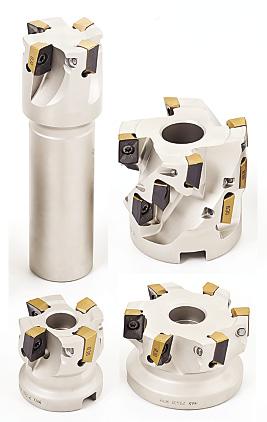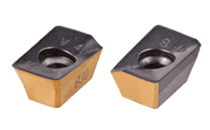Technical Advisor
- FMA
- The Fabricator
- FABTECH
- Canadian Metalworking
Tool Tech: Intelligent Milling
Exploring chatter free indexables.
- By Andrei Petrilin
- October 22, 2015
The chatter—vibration in metal cutting—poses an eternal headache for manufacturers. In machining, vibration brings about poor surface finish, loss of accuracy, reduced tool life and intensive wear of critical machine tool parts. While trying to prevent these negative effects, manufacturers are obliged to use expensive vibration-resistant tooling devices and reduce cutting data.
In metal cutting, every possible means for reducing vibration is important for improving performance. Various methods intended for this objective include changes in workholding principles, using more rigid clamping fixtures, adoption of toolholders with vibration damping properties, etc.
In milling, periodically changed impact load and thickness are sources of forced and self-generated vibrations. Therefore, prevention of chatter in milling is very important. For tool manufacturers, searching for an appropriate response is limited in possible design solutions. Basic design principles include using the highest possible rigidity and strength of a milling cutter, progressive cutting geometry and so on. There are also some specific principles that allow creating a robust vibration-proof cutting tool, including an unequal tooth pitch (angle pitch). In the case of solid carbide endmills, a variable helix angle significantly improves chatter stability. Also, a cutting edge with chip splitting action has definite advantages and effectively helps in reducing vibrations. Attempts to apply these principles to indexable milling cutters (with inserts) often meet with difficulties. Making a chip splitting cutting edge has led to success. However, making indexable milling tools with a variable positive axial rake is associated with a lot of design constraints. Varying axial rake angle by changing the inclination of an insert pocket is actually very limited—a correct design has to ensure proper tool back clearance.
The design of the one-sided insert HM90 ADCT 1505 ...-CF, which is intended for clamping into the milling cutters of the HELI2000 family, fundamentally uses a different approach.
A typical laydown indexable milling insert features rotational symmetry of its cutting edges about an axis perpendicular to the insert base. As a rule, it is the axis of a mounting hole. The new product bends this classical configuration. The insert has two helical cutting edges, but their inclination to the base is different. Consequently, when the insert is clamped into a tool, its cutting edges produce various axial rakes. Thus, the achieved result is similar to the variable helix angle of the solid endmills, which is so effective in the reduction of vibrations during machining.
Important to note, the new asymmetric insert is suitable for already existing milling cutters. This feature provides improvement of the cutters’ performance in shoulder milling when rigidity of a technological system is low: high cutter overhang, thin-walled workpiece, problematic workholding, etc. As a result, the tool life of the insert increases by 15 to 20 per cent and the power consumption is reduced by 10 per cent.
Development of powder metallurgy and pressing technology will bring further increases of the height difference between corners of an insert and therefore will expand possibilities of changing the axial rake. Moreover, the portions of the rake face adjacent to the cutting edges may have a different topology that also allows varying the normal rake. These properties provide a good base for producing vibration-proof indexable milling tools. It is especially a high potential for extended flute cutters, the tooth of which is formed by a set of inserts. The new solution opens several options for varying the cutter geometry only by changing the order of mounting the inserts on the pockets:
- a consistent tool axial rake
- an alternating tool axial rake from one flute to another
- a variable tool axial rake along each flute
The peripheral surfaces of Iscar’s insert HM90 ADCT 1505 ...-CF have different colours: golden on one side and black on the other. This seemingly ordinary detail is convenient. It serves as an indication of edge inclination and makes mounting the inserts in a desired order simple.
Chatter has a complex nature. Simulating vibrations is difficult—it depends on many factors. In the design stage, simulation does not always help to find the geometry of a vibration-proof indexable milling cutter for broad-spectrum applications. Therefore, the ability of simple “cutter tuning” for a vibration-free mode only by changing the order of insert clamping looks very promising.
Andrei Petrilin is application/project engineer, milling manager with Iscar.
subscribe now


Keep up to date with the latest news, events, and technology for all things metal from our pair of monthly magazines written specifically for Canadian manufacturers!
Start Your Free SubscriptionAbout the Author
Andrei Petrilin
2100 Bristol Circle
Oakville, L6H 5R3 Canada
905-829-9000
- Trending Articles
Automating additive manufacturing

Identifying the hallmarks of a modern CNC

CTMA launches another round of Career-Ready program

Collet chuck provides accuracy in small diameter cutting

Sandvik Coromant hosts workforce development event empowering young women in manufacturing

- Industry Events
MME Winnipeg
- April 30, 2024
- Winnipeg, ON Canada
CTMA Economic Uncertainty: Helping You Navigate Windsor Seminar
- April 30, 2024
- Windsor, ON Canada
CTMA Economic Uncertainty: Helping You Navigate Kitchener Seminar
- May 2, 2024
- Kitchener, ON Canada
Automate 2024
- May 6 - 9, 2024
- Chicago, IL
ANCA Open House
- May 7 - 8, 2024
- Wixom, MI

















